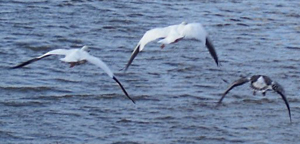Natural selection: hunters miss out when targeting one species
November 17, 2008
A bitter chill in the air and a frost underfoot can only mean one thing for the experienced sportsman: goose season is fast approaching.
Goose hunting has become increasingly popular through the years thanks to hunting videos, shows and games. You’d be hard pressed to enter a sporting goods shop without seeing a row of goose calls, with average prices ranging from $10 to $50. However, many casual sportsmen in Kansas only seek the thrill of pursuing one species of goose, leaving two very important and entertaining species out of the mix.
Canada geese
The Canada goose is perhaps the most sought after of the three main groups. This branch is broken up into two categories: greater (larger) and lesser (smaller). The Canada goose, also known as the honker to locals for its signature call, is the iconic species of goose. It is often the toughest to hunt, thanks to keen eyesight and a durability that even the best shooters often curse. Some regard the honkers as the smartest of the geese family, primarily because of their persnickety nature toward flying into decoys.
To get an edge up on the competition, follow some of the basic rules of building a decoy setup in corn fields where geese fly in to feed: face them into the wind, break the setup into groups of two with space in the middle where you want the birds to land and position the decoys differently throughout the spread (standing, resting and sentries). You can also use three letter shapes to help design a spread: X, Y and J. Any of these shapes can work for you and really depend on where you want the birds to land.
When shooting, it’s better to over-lead than under-lead. Geese are deceptively fast and hunters must aim to where the geese will be, not where they are. Head shots are the most efficient way to take down a honker, as wing shots are more prone to simply clip them. Honkers are perhaps some of the toughest birds in the sky.
White-fronted geese
White-fronted geese, or speckle bellies, are one of the rarer species of geese. These geese are found more by luck than planning, as they often travel and feed with light geese. The daily bag limit for white-fronted geese (two) is even more sparse than the limit for Canada geese, so solo shots are a better option than firing into a group.
These geese, much like the Canadians and light geese, have their own unique calls and can be vocally picked out fairly easily from other species. While the big Canadians are the bread and butter of goose hunting, you can consider this species to be a fine delicacy.
Light geese
The last and most numerous of the Kansas species are the light geese, which can be broken into three subcategories (snows, blues and ross’). Snows and blues are basically the same species but a different color, with snow geese being all-white and blues having a bluish-black body with a white head. Ross’ are similar to the snows but smaller and with a shorter beak.
Some hunters use decoys or white plastic bags to create large setups that attract the huge bunches of light geese that populate the Kansas skies.
Another effective, albeit costly, way to hunt light geese is by vehicle. Many hunters attempt this form of hunting, driving around the cornfields of the countryside after sunrise, checking their binoculars for signs of a mass of birds in the skies or a large, white gathering in some open field. After locating a field where they’ve landed and getting permission from the owner, they then use draws, treelines, hills or other features of the terrain to stay hidden and stalk their prey. This can mean miles of duck-walking or crawling, as they like to get up from time to time and move about the field (especially during the middle and end of the season when they’ve been hunted regularly).
However, the benefits of a successful jump are much higher than the other species. Hunters may bag a daily limit of 20 birds per person during the regular season, meaning four licensed hunters could garner up to 80 birds any given morning. It may sound hard to believe, but I can tell you from past experiences that there have been days where it is achievable. After the regular season, the extended season kicks in and the daily bag limit is dropped, giving hunters the liberty to shoot as many geese as they see fit. Hunters can also take the plugs out of their guns, which are mandatory for all other species of birds and limit hunters to carrying only three shells at a time inside their shotguns.
The light geese populations are so numerous that they literally eat themselves out of house and home. Without hunting these birds to keep the population in check, they would eventually kill themselves off completely, as well as many other species that rely on the same food sources.
Current seasons: Fall turkey – Oct. 1-Dec. 2, Dec. 15-31, Jan. 5-31 Trapping – Nov. 12-Feb. 15 Beaver trapping – Nov. 12- March 31 Dove – Nov. 20-Feb. 28 Snipe – Sept. 1-Dec. 16 Woodcock – Oct. 11-Nov. 24 Ducks, late zone – Oct. 25- Dec. 28, Jan. 17-25 Canada geese – Nov. 5-Feb. 15 White-fronted geese – Nov. 5- Jan. 4, Feb. 7-15 Light geese – Nov. 5-Feb. 15, Feb. 16-April 30* Sandhill crane – Nov. 5-Jan. 1 Pheasant – Nov. 1-Jan. 31 Quail – Nov. 8-Jan. 31 Squirrel – June 1-Feb. 28 Rabbits – All year Crow – Nov. 10-March 10 Deer, archery – Sept. 22-Dec. 31 Elk, archery – Sept. 22-Dec. 31
Upcoming seasons: Deer, firearm – Dec. 3-14 Elk, firearm – Dec. 3-14, Jan. 1- March 15 *No daily bag limit



